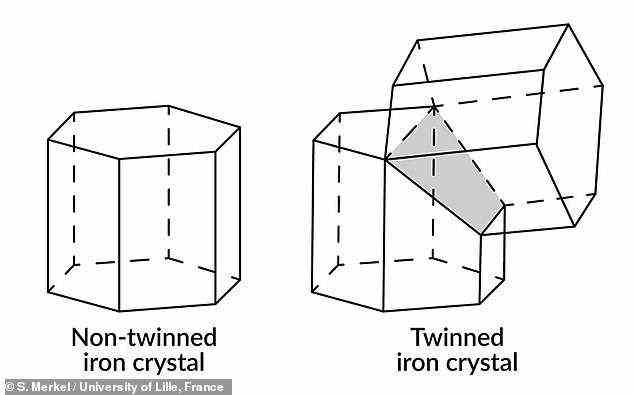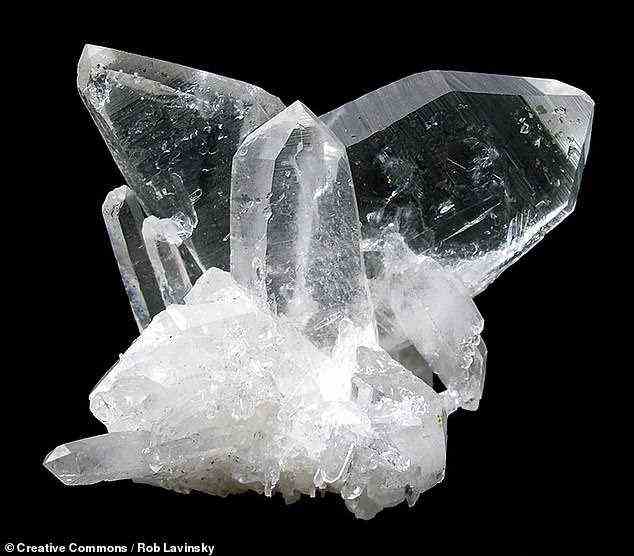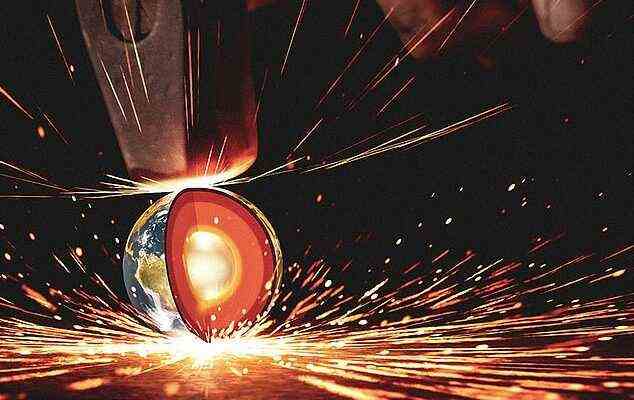Bei den extremen Drücken am Boden des äußeren Erdkerns nimmt Eisen eine stärkere Form an, um die Belastungen in einem Prozess namens „Zwillingen“ zu bewältigen.
Dies ist das Ergebnis einer Studie von Forschern des SLAC National Accelerator Laboratory, die den Druck des Kerns im Labor nachgebildet haben.
Sie taten dies, indem sie zwei Laser auf eine Eisenprobe von der Breite eines menschlichen Haares richteten. Die erste erzeugte eine Stoßwelle, die das Metall flüchtig erhitzte und komprimierte.
Der zweite Laser – Teil der Linac Coherent Light Source von SLAC – ermöglichte es dem Team, die Auswirkungen auf die Atomstruktur des Eisens innerhalb einer Milliardstelsekunde zu untersuchen.
Bei den extremen Drücken am Boden des äußeren Erdkerns (im obigen künstlerischen Schnitt gezeigt) nimmt Eisen eine stärkere Form an, um die Belastung in einem Prozess namens “Zwillingen” zu bewältigen. Dies ist das Ergebnis einer Studie von Forschern des SLAC National Accelerator Laboratory, die den Druck des Kerns im Labor nachgebildet haben
Ein Großteil des Eisens, dem Sie unterwegs begegnen könnten – sei es in Gebäuden, Maschinen, viktorianischen Laternenpfählen usw. – hat eine Struktur, die Kristallographen als „kubisch körperzentriert“ bezeichnen würden.
Dies bedeutet, dass das Kristallgitter in einem Muster nanoskopischer Würfel angeordnet ist, mit Eisenatomen in jedem Würfelzentrum sowie in jeder der acht Ecken.
Wenn Eisen jedoch höheren Drücken ausgesetzt wird, ändert sich diese Struktur – sie nimmt über 10 Gigapascal eine hexagonale Form an, die es den Atomen ermöglicht, sich enger zusammenzupacken.
In ihrer Studie wollten die Autorin und Geologin Arianna Gleason vom SLAC und ihre Kollegen sehen, was mit der hexagonalen, dicht gepackten Form von Eisen passiert, wenn man den Druck weiter auf den im Erdkern gefundenen erhöht.
„Wir haben nicht ganz die Bedingungen für den inneren Kern geschaffen, aber wir haben die Bedingungen für den äußeren Kern des Planeten erreicht – was wirklich bemerkenswert ist“, sagte Professor Gleason.
Das Team war sich nicht sicher, wie Eisen auf solch extreme Bedingungen reagieren würde – das entspricht etwa dem 360-Millionen-fachen des Drucks an der Erdoberfläche und so heiß wie die Oberfläche der Sonne –, da dies bisher niemand beobachtet hatte.
Es stellt sich heraus, dass Eisen einen anderen strukturellen Übergang durchläuft, ähnlich dem von einer kubischen zu einer hexagonalen Form, die es bei viel niedrigeren Drücken erfährt.
“Während wir es weiter vorantreiben, weiß das Bügeleisen nicht, was es mit dieser zusätzlichen Belastung anfangen soll”, erklärte Professor Gleason.
Sie fuhr fort: “Es muss diesen Stress abbauen, also versucht es, den effizientesten Mechanismus dafür zu finden.”
Der Bewältigungsmechanismus, auf den Eisen zurückgreift – die Zwillingsbildung – sieht die Anordnung der Atome zur Seite, wodurch alle sechseckigen Prismen um fast 90 Grad gedreht werden.
Zwillingsbildung ist eine häufige Druckreaktion in verschiedenen Mineralien und Metallen, einschließlich Calcit, Quarz, Titan und Zirkonium.
„Twinning ermöglicht es Eisen, unglaublich stark zu sein – stärker als wir zuerst dachten – bevor es auf viel längeren Zeitskalen plastisch zu fließen beginnt [than it would have otherwise,’ Professor Gleason said.

‘As we continue to push it, the iron doesn’t know what to do with this extra stress,’ Professor Gleason explained. ‘It needs to relieve that stress, so it tries to find the most efficient mechanism to do that.’ The coping mechanism that iron resorts to — twinning — sees the arrangement of atoms shunted to the side, rotating the hexagonal prisms by nearly 90°
‘Now we can give a thumbs up, thumbs down on some of the physics models for really fundamental deformation mechanisms,’ said Professor Gleason.
‘That helps to build up some of the predictive capability we’re lacking for modelling how materials respond at extreme conditions.’
Alongside this, the team explained, the same methods could be applied to better understand how other materials behave under extreme conditions.
Prior to their experiments, the researchers were unsure if iron would respond too fast for them to measure or too slow for them to ever see.
‘The fact that the twinning happens on the time scale that we can measure it as an important result in itself,’ explained paper author and geophysicist Sébastien Merkel of the University of Lille, France.

Twinning is a common pressure response in various minerals and metals, including calcite, quartz, titanium and zirconium. Pictured: a twinned crystal of quartz
‘The future is bright now that we’ve developed a way to make these measurements,’ added Professor Gleason, noting as well that recent upgrades to the Linac Coherent Light Source will allow materials to be studied at higher X-ray energies.
This, she explained, will enable studied of ‘thicker alloys and materials that have lower symmetry and more complex X-ray fingerprints’ — while also allowing larger samples to be observed, permitting a more comprehensive look at iron’s behaviour.
Furthermore, Gleason said, ‘we’re going to get more powerful optical lasers with the approval to proceed with a new flagship petawatt laser facility.
‘That’ll make future work even more exciting because we’ll be able to get to the Earth’s inner core conditions without any problem,’ she concluded.
The full findings of the study were published in the journal Physical Review Letters.

